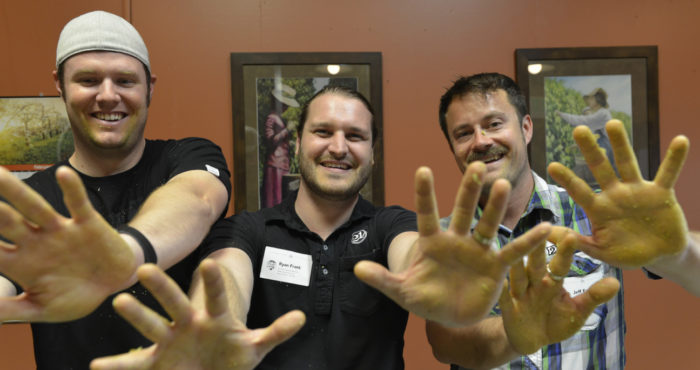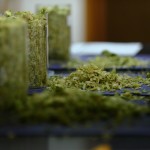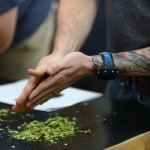BTW, is all that hop hand-rubbing really necessary?
One thing all rub-and-sniffers know is that any specific traits and aromatic particularities that may be picked up in a hop sample can easily vanish when brewed… just as others may arise to surprise and even confound you.

Every year in the late summer and early fall, brewers come to Yakima for the annual hop harvest to take a close look at the hop varieties they are purchasing. Much can be learned from these in-person evaluations of hop samples representative of what the brewers can expect to receive. Nothing compares to seeing…and smelling…the product up close, as well as talking to the growers and the producers personally, and to truly understand the factors that influence the hop crop and the quality of the final product.
 By far, the most popular method of hop aroma evaluation is the hand-rub analysis. But what about this time-honored practice that is so common? Isn’t it kind of archaic considering the fact that just about every step of the brewing process requires sophisticated analyses with advanced instrumentation? There’s gas chromatography (GC). Gas-chromatography mass spectroscopy (GC-MS). Heck, there’s even GC-MS olfactory analysis (GC-MS-O), which is capable of identifying aroma compounds down to the parts-per-TRILLION. Brewers and hop suppliers spend buckets of money on these capabilities and yet, every time you open some hops, they still rely on rubbing and sniffing the hops for the final determinations of quality. Why?
By far, the most popular method of hop aroma evaluation is the hand-rub analysis. But what about this time-honored practice that is so common? Isn’t it kind of archaic considering the fact that just about every step of the brewing process requires sophisticated analyses with advanced instrumentation? There’s gas chromatography (GC). Gas-chromatography mass spectroscopy (GC-MS). Heck, there’s even GC-MS olfactory analysis (GC-MS-O), which is capable of identifying aroma compounds down to the parts-per-TRILLION. Brewers and hop suppliers spend buckets of money on these capabilities and yet, every time you open some hops, they still rely on rubbing and sniffing the hops for the final determinations of quality. Why?
Seriously, how precise can a method be if it uses your hands as a reaction vessel? I see no standardized hand-rub method provided by the ASBC, EBC, BCOJ, IBD—not one single group involved with developing proper analytical protocol hops and beer! Plus, everyone who performs the rub-and-sniff does it a bit differently. I often see those who exercise the “dainty” method, as I call it, where one single hop cone is selected from the hop lot sample, split in half, rubbed together and gently sniffed (make sure those pinkies are raised). On the other end of the spectrum is the nuclear option…grabbing a handful of hops and with such vigor that it erupts into a flurry of rubbing, flailing and inhaling a veritable mushroom cloud of hop debris that usually ends up on the floor, walls and clothing (not to mention in hair and beards and, lately, waxed mustaches). I think they’d gleefully wallow in the hops if they could!
 What’s more, it’s a well-known fact that WYSINWYG (what you smell is not what you get), i.e. the aroma of the hops is not likely to be well represented in the final beer produced. That’s because the brewing process involves a lot of distillation, oxidation and biotransformation, and many of the beer’s important aroma-makers are undergoing a serious makeover.
What’s more, it’s a well-known fact that WYSINWYG (what you smell is not what you get), i.e. the aroma of the hops is not likely to be well represented in the final beer produced. That’s because the brewing process involves a lot of distillation, oxidation and biotransformation, and many of the beer’s important aroma-makers are undergoing a serious makeover.
So what are the rub-and-sniff aficionados looking for—and what do they expect to get out of it? Shouldn’t we just toss this business aside with all the other pseudo-science sideshows, like divining rods, bloodletting and Dancing with the Stars judging?
I say, absolutely not!
In fact, I am one of the most fervent advocates of the rub-and-sniff. I will concede that, objectively, yes, it has its weaknesses. But there’s a subjective aspect to capital-Q “Quality” that can only be measured by a tacit, emotional, non-quantitative response. A response that is pleasing to the senses, satisfying, and patently immeasurable. Take one look at all those brewers hamming it up for the photos; their hands caked in hop lupulin, huge Cheshire grins on their faces! Your first rub-and-sniff is a brewing rite of passage—and an olfactory confirmation of everything that connects brewers to the fields as much as to the brew house.
And, really—all fun and flippancy aside—there is actual value to the rub-and-sniff. When selecting or evaluating hops that will be used for your beers, you’ll certainly want the hops that you’re purchasing to be true-to-type—meaning they represent what’s typical for the hop variety you’re expecting. Off aromas can be indicators of issues that you want to be aware of. And the smell of a hop can give a general indication of what you can expect in the beer, if not specifically. Your nose will tell you the general personality of the hop; from a subtle introversion that may blend well in the nuances of a certain beer style, to a bold, brash trait that you can’t wait to taste expressed in the brew.
One thing all rub-and-sniffers do know is that any specific traits and aromatic particularities that may be picked up in a hop sample can easily vanish when brewed…just as others may arise to surprise and even confound you. It’s these surprises that make hops wonderful, some say magical, and perfect for the craft of brewing beer. So long live the rub-and-sniff!
Cheers!



